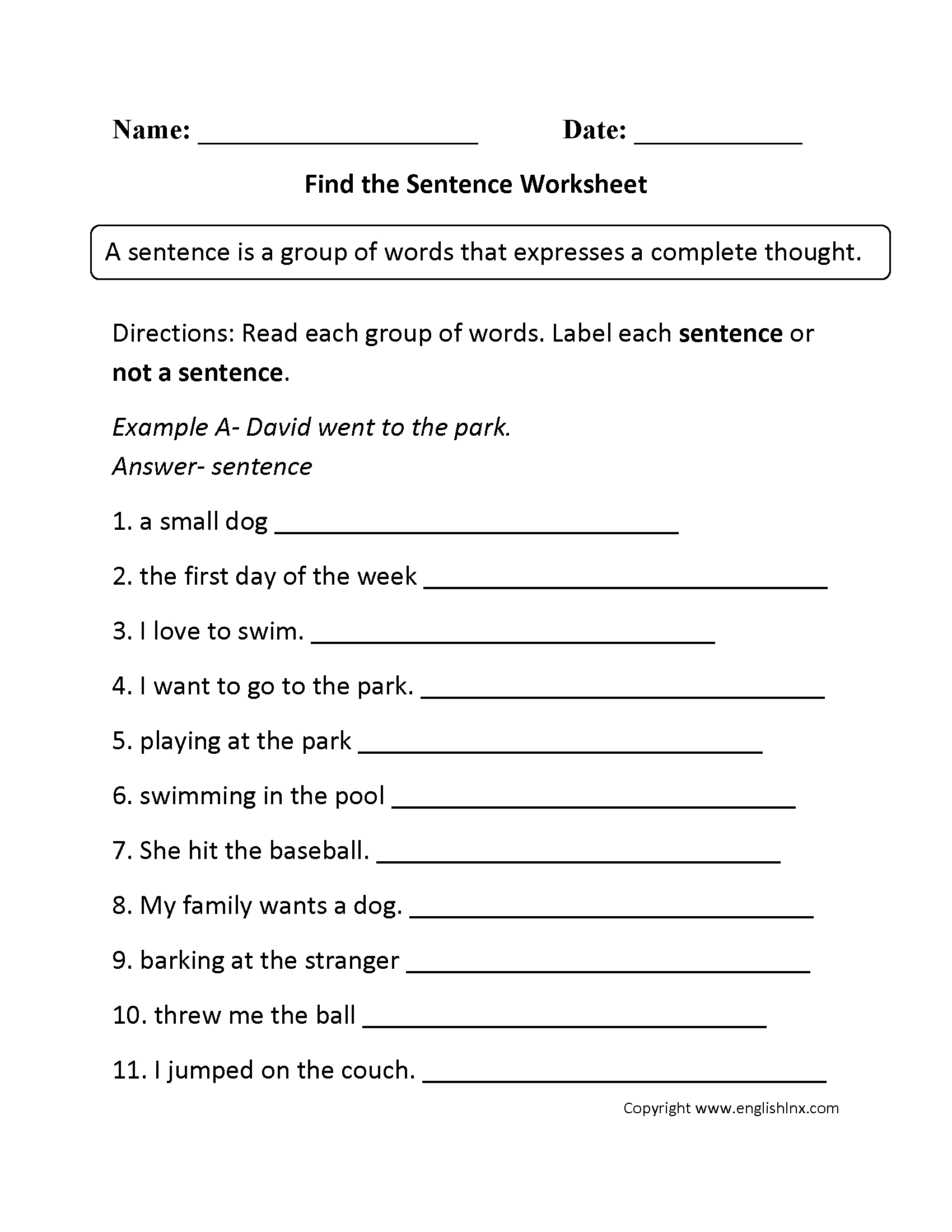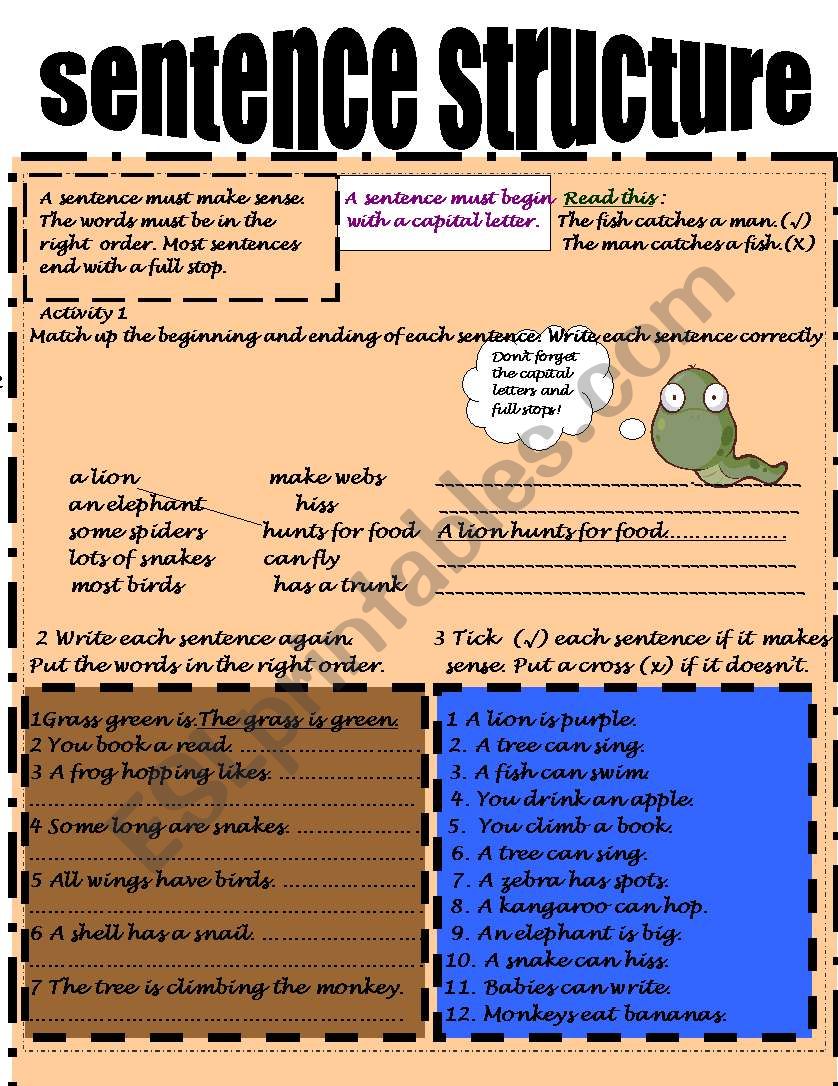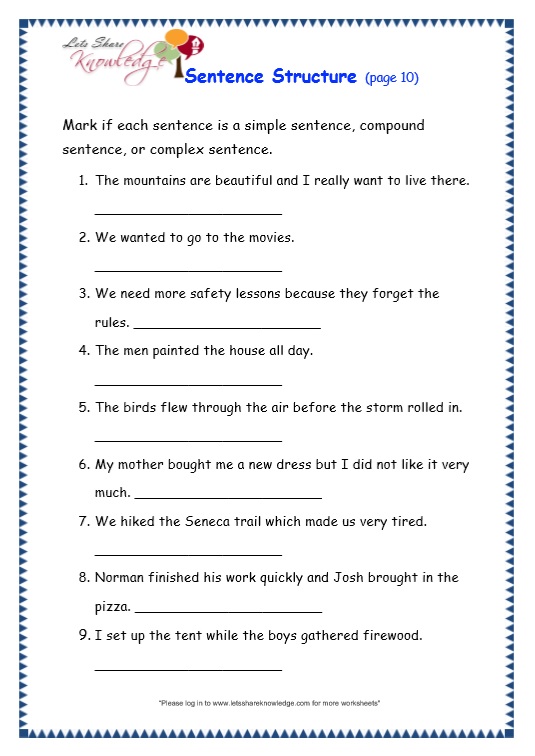
Mastering the Blueprint of Language: The Power of Sentence Structure Worksheets
Language, in its essence, is a complex tapestry woven from individual words. Yet, for these words to convey meaning, to express nuanced thoughts, and to evoke emotions, they must be arranged in a specific, logical order. This arrangement is what we call sentence structure. Understanding and mastering sentence structure is not merely a grammatical exercise; it is the cornerstone of effective communication, both written and spoken. For learners of all ages and proficiency levels, from nascent writers to advanced English as a Second Language (ESL) students, a powerful tool for developing this fundamental skill is the sentence structure worksheet.
Sentence structure worksheets serve as practical, hands-on guides that break down the intricate rules of English syntax into manageable, actionable exercises. They transform abstract grammatical concepts into concrete tasks, allowing learners to identify, analyze, build, and manipulate sentences with growing confidence and precision. This article will delve into the profound importance of these worksheets, explore the range of concepts they cover, discuss best practices for their effective use, and highlight their benefits for diverse learning needs, ultimately underscoring why they are an indispensable resource in language education.
The Indispensable Role of Sentence Structure Worksheets
![]()
Why dedicate time and effort to sentence structure worksheets? The reasons are manifold and deeply impact a learner’s overall linguistic proficiency:

- Clarity and Precision: A well-structured sentence conveys its message without ambiguity. Worksheets help learners understand how subject-verb agreement, placement of modifiers, and proper use of clauses contribute to clarity, preventing misunderstandings and misinterpretations.
- Enhanced Writing Skills: From crafting compelling essays to composing professional emails, strong writing hinges on the ability to construct varied and grammatically sound sentences. Worksheets provide the foundational practice needed to move beyond simple sentences, enabling students to write with sophistication and impact.
- Improved Reading Comprehension: Just as understanding sentence structure aids writing, it also significantly boosts reading comprehension. When readers can identify the main subject and verb, differentiate between independent and dependent clauses, and recognize the relationships between different parts of a sentence, they can more easily grasp the author’s intended meaning, even in complex texts.
- Critical Thinking and Analytical Skills: Analyzing sentence structure requires logical reasoning. Learners must identify patterns, apply rules, and sometimes even troubleshoot grammatical errors. This process sharpens their analytical abilities, skills transferable to many other academic and real-world challenges.
- Preparation for Standardized Tests: Many standardized English proficiency tests (such as TOEFL, IELTS, SAT, ACT) heavily feature sections on grammar, sentence correction, and essay writing. Consistent practice with sentence structure worksheets directly prepares students for these components, improving their scores and opening doors to academic and professional opportunities.
- Foundation for Advanced Communication: Mastery of basic sentence structures is a prerequisite for understanding more complex rhetorical devices, stylistic choices, and effective persuasive techniques. It’s the bedrock upon which all advanced communication skills are built.



Deconstructing Complexity: What Sentence Structure Worksheets Cover
The scope of sentence structure worksheets is broad, encompassing various levels of complexity and focusing on different grammatical elements. Typically, they progress from the fundamental to the more intricate, covering:

-

Basic Sentence Components:
- Subject and Predicate: Identifying the "who or what" the sentence is about (subject) and the "what it does or is" (predicate, containing the verb).
- Direct and Indirect Objects: Understanding who or what receives the action of the verb.
- Complements: Recognizing words or phrases that complete the meaning of the verb (e.g., predicate nominatives, predicate adjectives).

-
Types of Sentences by Structure:
- Simple Sentences: Focusing on a single independent clause (one subject, one verb). Worksheets might ask students to identify these or expand simple ideas into complete sentences.
- Compound Sentences: Combining two or more independent clauses, usually with coordinating conjunctions (FANBOYS: For, And, Nor, But, Or, Yet, So) or semicolons. Exercises often involve combining simple sentences into compound ones.
- Complex Sentences: Featuring one independent clause and one or more dependent clauses, linked by subordinating conjunctions (e.g., although, because, since, while, when) or relative pronouns (who, which, that). Worksheets might require identifying clauses, inserting appropriate conjunctions, or rewriting sentences to incorporate dependent clauses.
- Compound-Complex Sentences: The most intricate, combining elements of both compound and complex sentences (at least two independent clauses and at least one dependent clause). These exercises challenge learners to manage multiple ideas within a single sentence.
-
Phrases and Clauses:
- Differentiating Phrases from Clauses: Understanding that a phrase is a group of words without a subject-verb pair, while a clause contains both.
- Types of Phrases: Noun phrases, verb phrases, prepositional phrases, infinitive phrases, participial phrases, etc., and their roles in a sentence.
- Types of Clauses: Independent vs. dependent, and further categorization of dependent clauses (noun clauses, adjective clauses, adverb clauses) and their functions.
-
Punctuation and Flow:
- Commas: Correct use in compound and complex sentences, with introductory elements, in lists, etc.
- Semicolons: Linking related independent clauses.
- Colons: Introducing lists or explanations.
- Periods, Question Marks, Exclamation Points: Marking sentence boundaries.
- Run-on Sentences, Fragments, and Comma Splices: Identifying and correcting these common grammatical errors that stem directly from a misunderstanding of sentence boundaries and structure. Worksheets are particularly effective for isolating and practicing the correction of these issues.
Maximizing Effectiveness: Best Practices for Using Sentence Structure Worksheets
While sentence structure worksheets are powerful tools, their efficacy is significantly enhanced when used strategically:
- Gradual Progression: Start with the basics and slowly introduce more complex structures. Overwhelming learners with too much too soon can lead to frustration. A well-designed series of worksheets will naturally build upon previously learned concepts.
- Clear Instructions and Examples: Each worksheet should begin with concise, easy-to-understand instructions and provide clear examples of how to complete the tasks. Visual aids, like diagrams illustrating sentence components, can also be highly beneficial.
- Variety in Activities: Don’t stick to just one type of exercise. Incorporate a mix of:
- Identification: Underlining subjects, verbs, clauses.
- Completion: Filling in missing conjunctions or pronouns.
- Transformation: Rewriting simple sentences as compound or complex ones.
- Combination: Merging multiple short sentences into longer, more sophisticated ones.
- Error Correction: Finding and fixing grammatical mistakes related to structure.
- Creation: Prompting students to write original sentences using specific structures.
- Contextual Learning: Whenever possible, integrate worksheet exercises with real-world examples or texts. Instead of just abstract sentences, use excerpts from books, articles, or even student writing. This helps learners see the practical application of grammatical rules.
- Active Engagement and Discussion: Encourage students to discuss their answers, explain their reasoning, and even debate different approaches. Peer correction and group activities can deepen understanding.
- Constructive Feedback: Simply marking answers right or wrong isn’t enough. Provide specific feedback on why an answer is incorrect and offer guidance on how to improve. Encourage self-correction by providing answer keys for self-assessment.
- Integration with Writing: The ultimate goal of mastering sentence structure is to apply it in one’s own writing. After completing worksheets, assign writing tasks that require students to consciously use the structures they’ve practiced. For instance, "Write a paragraph using at least two complex sentences and one compound sentence."
- Leveraging Technology: Many online platforms offer interactive sentence structure worksheets with instant feedback, gamified elements, and adaptive learning paths, making the learning process more engaging and personalized.
Tailoring to Diverse Learners
One of the great strengths of sentence structure worksheets is their adaptability to various learning needs:
- ESL/EFL Learners: For non-native speakers, these worksheets are invaluable. They provide the systematic, rule-based practice necessary to internalize English syntax, which often differs significantly from their native languages. They help bridge the gap between understanding individual words and constructing coherent English sentences.
- Native Speakers (Struggling Writers): Even native English speakers can struggle with sentence structure, leading to monotonous, unclear, or grammatically incorrect writing. Worksheets offer targeted intervention, helping them identify and correct ingrained bad habits and develop more sophisticated writing styles.
- Younger Learners: For elementary and middle school students, worksheets can introduce foundational concepts in an accessible, step-by-step manner, building a strong grammatical base from an early age. They often feature simpler language and more engaging visuals.
- Adult Learners: Whether returning to education or learning English for professional reasons, adults can benefit from the structured approach of worksheets to refresh their knowledge or acquire new grammatical competencies efficiently.
Finding and Creating Effective Sentence Structure Worksheets
Resources for sentence structure worksheets are abundant:
- Online Educational Platforms: Websites like Teachers Pay Teachers, Khan Academy, K5 Learning, EnglishClub.com, and many university writing centers offer a plethora of free and paid worksheets covering various aspects of sentence structure.
- Textbooks and Curriculum Guides: Most reputable English language arts textbooks and grammar workbooks include extensive sections dedicated to sentence structure, often with accompanying exercises.
- Public Libraries and Resource Centers: Libraries often have shelves dedicated to grammar and writing resources, including workbooks and practice sheets.
- DIY: Crafting Your Own Worksheets: Educators can also create custom worksheets tailored to their students’ specific needs, using current texts or common errors observed in student writing as source material. This allows for highly relevant and targeted practice.
Conclusion
The journey to linguistic mastery is multifaceted, but at its core lies the ability to construct clear, coherent, and impactful sentences. Sentence structure worksheets are not just drills; they are essential tools that empower learners to dissect, understand, and ultimately command the very blueprint of the English language. By providing structured practice, immediate application, and opportunities for analytical thinking, these worksheets transform abstract grammatical rules into tangible skills. They equip individuals with the precision needed for academic success, the clarity required for professional communication, and the confidence to express themselves effectively in an increasingly interconnected world. Embracing the consistent use of well-designed sentence structure worksheets is an investment in linguistic competence that yields profound and lasting dividends.
